Medium
2d
81

Image Credit: Medium
Mastering SIEM: Optimization Strategies and Practical Tools for Entry-Level Analysts
- Practical strategies and tools recommended for entry-level security analysts include exploring data, building dashboards, writing detections, mapping to MITRE ATT&CK, simulating adversary behavior, and developing investigation workflows.
- Hands-on lab setup, log ingestion, targeted detection writing, and adversary technique simulation are essential to quickly acquire core SIEM skills for entry-level analysts.
- For organizations lacking dedicated security teams, partnering with Managed Security Services Providers (MSSPs) can offer continuous SIEM monitoring, expert tuning, and 24/7 support for maintaining effective threat detection.
- Integration of best-practice tuning, AI-driven automation, and external expertise can elevate SIEM from a reactive tool to a strategic asset for proactive threat detection and response.
Read Full Article
4 Likes
For uninterrupted reading, download the app